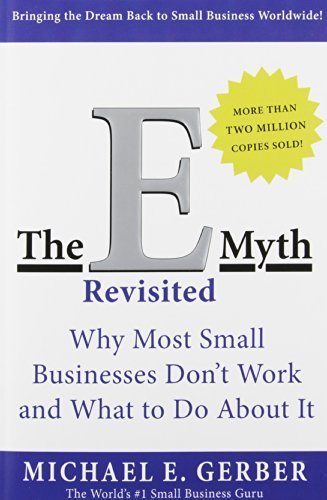The E-Myth Revisited - Michael Gerber

Part I: The E-Myth And American Small Business
The perpetuation of the E-Myth is why many small businesses fail today. You should understand the E-Myth and apply it to start and grow a successful business.
Chapter 1. The Entrepreneurial Myth
The Myth of the Entrepreneur is known as the E-Myth:
E-Myth – the myth “that small businesses are started by entrepreneurs risking capital to make a profit”
In your day job working for someone else, you become struck with the entrepreneurial seizure:
The Entrepreneurial Seizure – the thought that you can quit your job, be your own boss, and run your own business
And so, you fell prey to a fatal assumption made by all technicians that try to go into business:
The Fatal Assumption – “if you understand the technical work of a business, you understand a business that does that technical work,” but these are two totally different things:
- Technical Work of a Business – the application of technical knowledge and technical skills to perform specific tasks
- Business that does Technical Work – an organization that produces and sells goods and services for profit
The result is that “an entrepreneurial dream turns into a technician’s nightmare” by taking the work they enjoyed doing and turning it into a job.”
Chapter 2. The Entrepreneur, The Manager, And The Technician
The E-Myth Revisited argues that going into business depends on taking on these three personalities at once:
- The Entrepreneur – the leader who “defines the business and focuses on closing the gap between where the business is today and where they want it to be”
- The Manager – the supervisor who “focuses on achieving results through people and systems, focusing on the present and strategizing for the future”
- The Technician – the specialist who “lives in the present and is focused on doing the work of making it, selling it, and delivering it”
Ideally, the personalities would be balanced; however, the “typical small business owner is only 10 percent Entrepreneur, 20 percent Manager, and 70 percent Technician.”
Chapter 3. Infancy: The Technician’s Phase
The E-Myth Revisited states that small businesses are supposed to grow and change. However, most businesses operate “according to what the owner wants than what the business needs.”
There are three phases in a business’s growth, with the first phase being Infancy:
Infancy – “the start-up phase of your business when you act as a technician doing all the work of the business yourself”
Businesses in infancy are characterized by the owner and business being synonymous. You dedicate many personal resources to it, but it takes its toll. This stage ends when the owner understands that they can’t run the business this way forever and need help to learn and grow.
Chapter 4. Adolescence: Getting Some Help
The owner must be willing to change to survive and reach the second stage in business growth:
Adolescence – the growth stage of your own business when “you hire employees to take over some of the tasks that used to overwhelm you”
You hire technical help who has experience in your type of business, and it goes well at first. However, you later find that your employees are not as dedicated as you are and work is not getting done as you would like. As a result, you believe that you will produce the best work, sideline your employees, and insert yourself back into the technician role.
Chapter 5. Beyond The Comfort Zone
Within the Adolescent stage, owners are pushed to the limits of their comfort zone:
Comfort Zone – “the boundary within which he feels secure in his ability to control his environment, and outside of which he begins to lose that control;” for each personality:
- Technician’s Boundary – “determined by how much he can do himself”
- Manager’s Boundary – “defined by how many technicians he can supervise effectively or how many subordinate managers he can organize into a productive effort”
- Entrepreneur’s Boundary – determined by “how many managers he can engage in pursuit of his vision”
As a business grows, the business owner eventually becomes unable to control it and tries to promote managers. When the business grows beyond the owner’s Comfort Zone, it tends to go into a tailspin and leaves the owner with three possible choices
- Return to Infancy: The business reverts to a smaller, simpler entity when you did everything yourself, eventually becoming a job that owns you.
- Go for Broke: The business multiplies as customer demand outpaces its ability to produce until it catastrophically destructs under its own momentum.
- Survive in Adolescence: The business survives with you being consumed by working in it and the key idea of possibly losing it.
However, there is a better way of educating and preparing yourself for growth by establishing a business structure with processes, objectives, and strategies to handle the additional weight.
Chapter 6. Maturity And The Entrepreneurial Perspective
The E-Myth Revisited states that the best companies survive past adolescence and embody the third phase of business growth:
Maturity – the stage in which the “business knows how it got to be where it is, and what it must do to get to where it wants to go”
In Maturity, a successful business is founded on the entrepreneurial perspective:
Entrepreneurial Perspective – the business approach when one has “a clearly defined vision, with accountability standards and direction that drives the business to success”
Unlike the technician focused on the product or work, the business owner has a broader perspective of seeing the mature business as a product itself. The entrepreneur wants to satisfy the needs of a niche of customers innovatively, especially when compared to others in the market